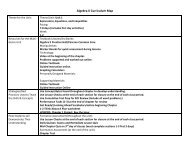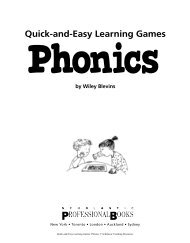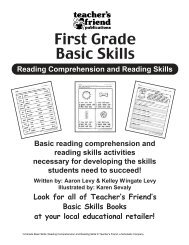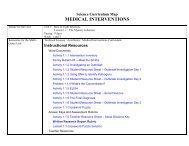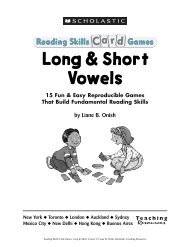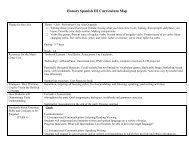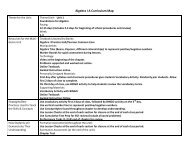Physical Science (CH) Curriculum Map
Physical Science (CH) Curriculum Map
Physical Science (CH) Curriculum Map
You also want an ePaper? Increase the reach of your titles
YUMPU automatically turns print PDFs into web optimized ePapers that Google loves.
<strong>Physical</strong> <strong>Science</strong> (<strong>CH</strong>) <strong>Curriculum</strong> <strong>Map</strong><br />
Theme for the Unit: Theme / Unit Chapter 16 What is Matter<br />
Pacing: 8 days<br />
Week: 1-2<br />
Resources for the Multi-<br />
Genre Unit<br />
Textbook Lessons / Ancillaries:<br />
CPO Foundations of <strong>Physical</strong> <strong>Science</strong> textbook and lab manual<br />
Manipulatives:<br />
Mixture vs. Substance Identification (using actual materials); Use an apple to demonstrate physical/chemical changes—<br />
exemplifies both; Magnetic cling manipulatives with particles for phase change<br />
Personally Designed Materials:<br />
Guided Reading worksheets<br />
Lab / Experiments:<br />
Demonstrations of physical and chemical changes; Making Butter; Homemade Ice Cream; Mixtures vs. Substances<br />
activity<br />
Strategies / Best Practices<br />
Used to Teach the Skills &<br />
Concepts<br />
How Students will<br />
Demonstrate Their<br />
Understanding<br />
Standards-based Essential<br />
Skills and Concepts to be<br />
Targeted<br />
(PASS +)<br />
lots of examples and discussion of key points<br />
Formative Assessments<br />
(throughout the unit):<br />
16.1 quiz (substance vs. mixture); physical and chemical changes worksheets; vocabulary quiz; chapter review<br />
Summative Assessment (at the end of the unit): chapter test<br />
Process Standards<br />
Observe and Measure:<br />
1. Identify qualitative and quantitative changes given conditions (e.g., temperature, mass, volume, time, position, length) before,<br />
during, and after an event.<br />
2. Use appropriate tools (e.g., metric ruler, graduated cylinder, thermometer, balances, spring scales, stopwatches) when<br />
measuring objects and/or events.<br />
3. Use appropriate System International (SI) units (i.e., grams, meters, liters, degrees Celsius, and seconds); and SI prefixes (i.e.<br />
micro-, milli-, centi-, and kilo-) when measuring objects and/or events.
Classify:<br />
1. Using observable properties, place an object or event into a classification system.<br />
2. Identify the properties by which a classification system is based.<br />
Experiment:<br />
1. Evaluate the design of a physical science investigation.<br />
3. Use mathematics to show relationships within a given set of observations.<br />
5. Recognize potential hazards and practice safety procedures in all physical science activities.<br />
Interpret and Communicate:<br />
1. Select appropriate predictions based on previously observed patterns of evidence.<br />
2. Report data in an appropriate manner<br />
5. Evaluate experimental data to draw the most logical conclusion<br />
8. Identify and/or create an appropriate graph or chart from collected data, tables, or written description<br />
Model:<br />
1. Interpret a model which explains a given set of observations.<br />
2. Select predictions based on models.<br />
3. Compare a given model to the physical world.<br />
Inquiry:<br />
3.Use a variety of technologies, such as hand tools, measuring instruments, and computers to collect, analyze, and display data. <br />
4. Inquiries should lead to the formulation of explanations or models (physical, conceptual, and mathematical). In answering<br />
questions, students should engage in discussions (based on scientific knowledge, the use of logic, and evidence from the<br />
investigation) and arguments that encourage the revision of their explanations, leading to further inquiry.<br />
Content Standards<br />
Standard 1: Structure and Properties of Matter - All matter is made up of atoms. Its structure is made up of repeating<br />
patterns and has characteristic properties. The student will engage in investigations that integrate the process standards<br />
and lead to the discovery of the following objectives:<br />
1. Matter is made up of minute particles called atoms, and atoms are composed of even smaller components (i.e., protons,<br />
neutrons, and electrons).<br />
2. An element is composed of a single type of atoms. When elements are listed in order according to the number of protons<br />
(called the atomic number), repeating patterns of physical and chemical properties identify families of elements with similar<br />
properties.<br />
3. Matter has characteristic properties, such as boiling points, melting points, and density, which distinguish pure substances and<br />
can be used to separate one substance from another.<br />
Theme for the Unit:<br />
Theme / Unit Ch 17 Properties of Matter<br />
Pacing: 9 days<br />
Week: 2-4
Resources for the Multi-<br />
Genre Unit<br />
Textbook Lessons / Ancillaries: CPO <strong>Physical</strong> <strong>Science</strong>; Density worksheet; Density problems; It takes teamwork<br />
worksheet; Buoyancy problems; Density and conversion worksheets<br />
Manipulatives:<br />
Technology:<br />
Personally Designed Materials: Ch 17 Spider graphic<br />
Strategies / Best Practices<br />
Used to Teach the Skills &<br />
Concepts<br />
How Students will<br />
Demonstrate Their<br />
Understanding<br />
Standards-based Essential<br />
Skills and Concepts to be<br />
Targeted<br />
(PASS +)<br />
Lab / Experiments/Inquiry: Density Lab; Buoyancy Boats<br />
Formative Assessments<br />
(throughout the unit): Ch 17 Quiz<br />
Summative Assessment (at the end of the unit): Ch 17 Test<br />
Process Standards<br />
Observe and Measure: Process standard 1: observing is the first action taken by the learner to acquire new<br />
information about an object or event. Opportunities for observation are developed through the use of a variety of scientific<br />
tools. Measurement allows observations to be quantified.<br />
Classify:<br />
Experiment: Process standard 3: experimenting is a method of discovering information. If it requires making<br />
observations and measurement to test ideas. The student will accomplish these objectives to meet this process standard.<br />
Process standard 4: interpret and communicate- interpreting is the process of recognizing patterns in collected data by<br />
making inferences, predictions, or conclusions. Communicating is the process of describing, recording, and reporting<br />
experimental procedures and results to others. Communication may be oral, written, mathematical and includes organizing<br />
ideas, using appropriate vocabulary, graphs, other visual representation, and mathematical equations.<br />
Model: Process standard 5: modeling is the active process of forming a mental or physical representation from<br />
data, patterns, or relationships to facilitate understanding and enhance prediction.<br />
Inquiry: Process standard 6: inquiry can be defined as the skills necessary to carry out the process of scientific or<br />
systemic thinking. In order for inquiry to occur, students must have opportunity to ask a question, formulate a procedure,<br />
and observe phenomena.<br />
Content Standards<br />
Standard 1: structure and properties of matter- all matter is make up of atoms. Its structure is made up of repeating<br />
patterns and has characteristic properties. The student will engage in investigations and lead to the discovery of the<br />
following objectives.
Matter is made up of minute particles called atoms, and atoms are composed of even smaller components (i.e.,<br />
protons, neutrons, and electrons)<br />
An element is composed of a single type of atom. When elements are listed in order according to the number of<br />
protons (called the atomic number), repeating patterns of physical and chemical properties identify families of<br />
elements with similar properties.<br />
Matter has characteristic properties, such as boiling points, melting points, and density, which distinguish pure<br />
substances and can be used to separate one substance from another.<br />
Theme for the Unit:<br />
Resources for the Multi-<br />
Genre Unit<br />
Theme / Unit Ch 18 Parts of an Atom<br />
Pacing: 12 days<br />
Week: 5-7<br />
Textbook Lessons / Ancillaries: CPO <strong>Physical</strong> <strong>Science</strong>; Which Atom is Which worksheet; Protons, neutrons, and electrons<br />
worksheet; A world famous table worksheet; Who am I worksheet; Atomic structure worksheet<br />
Manipulatives: Element Mobile; Atom builder game<br />
Technology: Periodic table Video<br />
Personally Designed Materials: Ch 18 Spider graphic; Guided reading; Periodic Table Video worksheet; periodic tables<br />
Lab / Experiments/Inquiry:<br />
Strategies / Best Practices<br />
Used to Teach the Skills &<br />
Concepts<br />
How Students will<br />
Demonstrate Their<br />
Understanding<br />
Standards-based Essential<br />
Skills and Concepts to be<br />
Targeted<br />
(PASS +)<br />
Formative Assessments<br />
(throughout the unit): Ch 18 Quiz<br />
Summative Assessment (at the end of the unit): Ch 18 Test<br />
Process Standards<br />
Observe and Measure: Process standard 1: observing is the first action taken by the learner to acquire new<br />
information about an object or event. Opportunities for observation are developed through the use of a variety of scientific<br />
tools. Measurement allows observations to be quantified.<br />
Classify: Process standard 2: classifying establishes order. Objects and events are classified based on similarities,<br />
differences, and interrelationships.
Experiment: Process standard 4: interpret and communicate- interpreting is the process of recognizing patterns in<br />
collected data by making inferences, predictions, or conclusions. Communicating is the process of describing, recording,<br />
and reporting experimental procedures and results to others. Communication may be oral, written, mathematical and<br />
includes organizing ideas, using appropriate vocabulary, graphs, other visual representation, and mathematical equations.<br />
Model: Process standard 5: modeling is the active process of forming a mental or physical representation from<br />
data, patterns, or relationships to facilitate understanding and enhance prediction.<br />
Inquiry<br />
Content Standards<br />
Standard 1: structure and properties of matter- all matter is make up of atoms. Its structure is made up of repeating<br />
patterns and has characteristic properties. The student will engage in investigations and lead to the discovery of the<br />
following objectives.<br />
Matter is made up of minute particles called atoms, and atoms are composed of even smaller components (i.e.,<br />
protons, neutrons, and electrons)<br />
An element is composed of a single type of atom. When elements are listed in order according to the number of<br />
protons (called the atomic number), repeating patterns of physical and chemical properties identify families of<br />
elements with similar properties.<br />
Matter has characteristic properties, such as boiling points, melting points, and density, which distinguish pure<br />
substances and can be used to separate one substance from another.<br />
Theme for the Unit:<br />
Resources for the Multi-<br />
Genre Unit<br />
Theme / Unit: Chapter 19 “Atoms and Molecules” and Chapter 20 “Chemical Reactions”<br />
Pacing: 10 days<br />
Weeks: 8-9<br />
Textbook Lessons / Ancillaries: CPO Textbook, all sections from Chapters 19 and 20; Ions and Their Charges wsheet,<br />
Drawing Lewis Structures wsheet, Writing Simple Chemical Formulas wsheet, Naming Ionic and Covalent Compounds<br />
review packet, Balancing Chemical Equations wsheets<br />
Manipulatives: molecular model kits; using Legos to balance equations and build molecules<br />
Technology: computer, Smart Board<br />
Personally Designed Materials: all chapter notes and worksheets, as well as chapter review exercises are teacher-created<br />
Lab / Experiments: building molecular models; balancing chemical equations with Legos; observing chemical vs.<br />
physical changes lab
Strategies / Best Practices<br />
Used to Teach the Skills &<br />
Concepts<br />
How Students will<br />
Demonstrate Their<br />
Understanding<br />
Standards-based Essential<br />
Skills and Concepts to be<br />
Targeted<br />
(PASS +)<br />
Students apply their previous knowledge about matter and its interactions to better understand the structure of molecules,<br />
how atoms and ions form chemical bonds, and how chemical reactions are quantified by the balancing of a chemical<br />
equation.<br />
Formative Assessments (throughout the unit): Drawing Lewis Structures quiz; Writing Chemical Formulas quiz;<br />
Balancing Equations quiz<br />
Summative Assessment (at the end of the unit): Unit Test over chapters 19 and 20<br />
PROCESS STANDARDS<br />
Process Standard 1: Observe and Measure<br />
1. Identify qualitative changes in reactions and quantitative changes in chemical reactions given conditions (e.g., temperature,<br />
mass, volume, time, position, length) before, during, and after an event.<br />
2. Use appropriate tools (e.g., metric ruler, graduated cylinder, thermometer, balances, spring scales, stopwatches) when<br />
measuring objects and/or events.<br />
3. Use appropriate System International (SI) units (i.e., grams, meters, liters, degrees Celsius, and seconds); and SI prefixes (i.e.,<br />
micro-, milli-, centi-, and kilo-) when measuring mass volume and temperature.<br />
Process Standard 2: Classify<br />
1. Using observable properties, place an object or event (i.e., chemical versus physical, electrons into charge, electron levels,<br />
and reaction types) into a classification system.<br />
2. Identify properties by which a classification system is based.<br />
Process Standard 3: Experiment<br />
1. Evaluate the design of a chemistry laboratory investigation.<br />
3. Use mathematics to show relationships within a given set of observations (i.e., conservation of mass and stoichiometry).<br />
4. Identify a hypothesis for a given problem in chemistry investigations.<br />
5. Recognize potential hazards and practice safety procedures in all chemistry laboratory activities.<br />
Process Standard 4: Interpret and Communicate<br />
1. Select appropriate predictions based on previously observed patterns of evidence.<br />
2. Report data in an appropriate manner.<br />
3. Interpret data tables, line, bar, trend, and/or circle graphs.<br />
4. Accept or reject hypotheses when given results of a chemistry investigation.<br />
6. Prepare a written report describing the sequence, results, and interpretation of a chemistry investigation or event.<br />
8. Identify and/or create an appropriate graph or chart from collected data, tables, or written description.<br />
Process Standard 5: Model<br />
1. Interpret an atomic model which explains a given set of observations.<br />
2. Select predictions based on models such as electron configuration, bonding, and compound formation.<br />
3. Compare a given model to the physical world.
Process Standard 6: Inquiry<br />
2. Design and conduct scientific investigations in which variables are identified and controlled.<br />
3. Use a variety of technologies, such as hand tools, balances, conductivity apparatus, thermometers, graduated cylinders,<br />
volumetric flasks, and computers to collect, analyze, and display data.<br />
4. Inquiries should lead to the formulation of explanations or models (physical, conceptual, and mathematical). In answering<br />
questions, students should engage in discussions (based on scientific knowledge, the use of logic, and evidence from the<br />
investigation) and arguments that encourage the revision of their explanations, leading to further inquiry.<br />
CONTENT STANDARDS:<br />
Standard 1: Structure and Properties of Matter<br />
1. Matter is made of atoms and atoms are composed of even smaller components (i.e., protons, neutrons and electrons).<br />
2. Atoms interact with one another by transferring or sharing outer electrons that are farthest from the nucleus. These outer<br />
electrons govern the chemical properties of the element.<br />
3. An element is composed of a single type of atom. When elements are listed in order according to the number of protons,<br />
repeating patterns of physical and chemical properties identify families of elements with similar properties.<br />
4. A compound is formed when two or more kinds of atoms bind together chemically. Each compound has unique chemical and<br />
physical properties.<br />
5. Solids, liquids, and gases differ in the energy that binds them together.<br />
Standard 2: Chemical Reactions:<br />
1. A large number of important reactions involve the transfer of either electrons (oxidation/reduction) or hydrogen ions<br />
(acid/base reactions).<br />
3. Chemical substances react in definite molar weight proportions.<br />
4. Mass is conserved in chemical reactions (balancing of equations).





